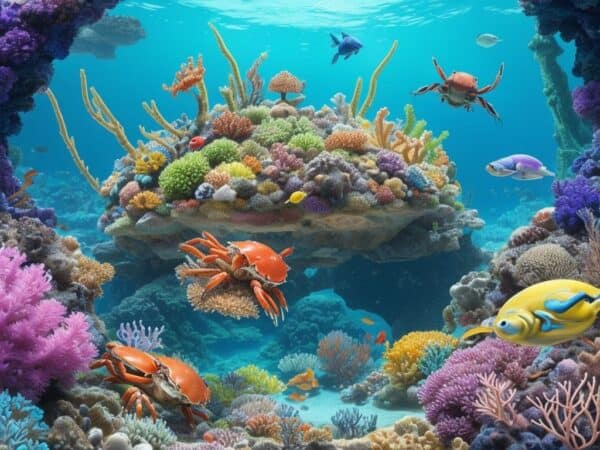Aquarium lovers are always on the lookout for something special. Unconventional crabs offer a unique addition to any underwater haven. They come in all shapes, sizes and colors, adding vibrancy and a touch of artistry.
Their behaviors fascinate aquarists of all levels. For example, the Sally Lightfoot crab’s agility and acrobatics provide entertainment. The Atlantic ghost crab’s ability to vanish is mysterious.
Compatibility is key when introducing these crabs. Research their needs; water conditions, tank size and diet, before selection. Space and hiding spots are also essential for their well-being.
To create an optimal habitat, diverse decorations, live rock structures or artificial corals, can mimic their natural environment. Also, stable water conditions and regular filtration system checks are vital to sustaining their health.
Benefits of Keeping Unconventional Crabs in Your Aquarium
Unconventional crabs can bring many benefits to your aquarium. They add excitement to your underwater world and create a captivating focal point. Here are four advantages:
- Enhanced Visual Appeal: Unconventional crabs come in a range of colors and patterns, making them eye-catching. Their shapes and sizes add diversity to your aquatic environment.
- Natural Algae Control: Many unconventional crabs eat algae, which can help control its growth in your tank. This reduces the need for chemical treatments, creating a healthier environment.
- Behavioral Fascination: Observing the behavior of unconventional crabs is fascinating. From exploring to intricate maneuvering, these creatures offer endless opportunities for observation and study.
- Educational Value: Keeping unconventional crabs in your aquarium provides an educational opportunity. By learning about their habitats, behaviors, and dietary needs, you can gain a deeper understanding of aquatic ecosystems.
Some types of crabs can even change color! But it’s important to research each species’ care requirements before adding them to your collection.
The boxer crab (Lybia tessellata) has a symbiotic relationship with anemones. It carries small anemones in its claws for protection against predators. This showcases the adaptability and resourcefulness of these creatures.
Adding unconventional crabs to your aquarium brings visual appeal and excitement. They also contribute to the overall health and balance of your aquatic ecosystem.
Types of Aquarium-Friendly Unconventional Crabs
Unusual crabs make awesome additions to your aquarium! They bring vibrancy and personality. Let’s look at different types of these aquarium-friendly crabs.
| Crab Type | Size | Habitat | Feeding Behavior |
| Peacock Mantis Shrimp | Up to 15 inches | Coral Reefs | Ambush Predator |
| Pom Pom Crab | Up to 1 inch | – Live rock – Anemones – Coral reefs – Mangrove roots – Seagrass beds |
This crab carries an anemone or soft coral in its pincers, using it for self-defense. It defends itself by waving the anemone or soft coral. |
| Abyssal Crab | Unknown | Extreme depths, up to 13,100 feet below the ocean surface | Generally peaceful. Can coexist with tank inhabitants peacefully. |
Not all crabs are available in the aquarium trade. But researchers discovered a new species of “Neon Hermit Crab” with fluorescent colors. Future aquarium enthusiasts can look forward to something unique!
An aquarist shared a cool story about a decorator crab. This clever creature camouflages itself by attaching plants, debris, or even other animals to its body. The aquarist watched it decorate itself, changing its appearance often.
Unconventional crabs bring a “wow” factor to aquariums. Experienced hobbyists and newcomers will be mesmerized. Enjoy a captivating underwater world!
How to Set Up Your Aquarium for Unconventional Crabs
Setting up the perfect environment for unconventional crabs? Here’s the step-by-step guide!
- Get the right size aquarium – pick an aquarium that’s big enough for your crab species. Consider their adult size and provide enough room to move around.
- Create a suitable substrate – Unconventional crabs love sandy or gravel substrates. This looks like their natural habitat and they can burrow and hide.
- Maintain proper water conditions – Clean water is essential, and you must keep it at the appropriate temperature. Use a testing kit to check pH levels, ammonia, nitrate, and nitrite levels.
- Provide hiding spots – Unconventional crabs are nocturnal, so give them plenty of places to hide. Decorations such as rocks, caves, or driftwood make great hiding spots.
- Feed a balanced diet – Research the dietary requirements of your crab species. A balanced diet of crab food, fresh vegetables, and occasional treats is ideal.
Remember, each species has different needs. Do research on the particular species you plan to keep and tailor your setup accordingly.
Pro Tip: Before introducing any new crab, make sure they are compatible with existing tankmates in terms of size and temperament.
Feeding and Care for Unconventional Crabs
Feeding and caring for unconventional crabs needs detail and knowledge. These creatures have special dietary requirements and need special attention to do well in an aquarium.
To maintain the health of unconventional crabs, it’s important to give them a balanced diet. This includes commercial crab food, like pellets or flakes, as well as fresh food like shrimp, fish, and veggies. It’s good to vary their diet to make sure they get all the nutrients.
Taking care of unconventional crabs also means creating a good environment in the aquarium. This includes hiding spots with rocks or caves, keeping the right temperature and quality of water, and making sure the crabs have enough space to move around.
The table below summarizes the important points about feeding and caring for unconventional crabs:
| Feeding | Care |
|---|---|
| Balanced diet | Provide hiding spots |
| Commercial crab food | Proper water temperature |
| Fresh foods | Maintain water quality |
| Variety of nutrients | Sufficient space |
Certain species of unconventional crabs have interesting feeding behaviors. For instance, the arrow crab has long legs that it uses to catch small prey, like bristle worms or small crustaceans. Knowing these behaviors can help give a more enjoyable experience to both the crab and the aquarium owner.
Finally, let’s look at a bit of history related to unconventional crabs. In 1904, Jean Bouvier discovered a new species of crab near Madagascar. This crab, called the Halloween crab because of its orange color, like pumpkins, was popular with aquarium fans due to its looks and behavior.
All in all, feeding and caring for unconventional crabs needs to be done with delicate attention to their dietary requirements and housing needs. By giving them a balanced diet, a suitable environment, and understanding their behaviors, aquarium owners can appreciate the beauty and surprise of these remarkable creatures.
Common Mistakes to Avoid When Keeping Unconventional Crabs
When it comes to keeping unconventional crabs in an aquarium, there are mistakes that should be avoided. These can harm the crabs’ health and welfare. To help, here is a table of the common mistakes to avoid:
| Mistake | Description |
|---|---|
| Inadequate space | Crabs need room to move. In cramped places, they get stressed and sick. |
| Improper diet | Provide a proper diet that meets their needs. Without balanced food, they can suffer malnutrition and health issues. |
| Lack of hiding spots | Crabs hide when scared. Without spots, they may become stressed or aggressive. |
| Incorrect water parameters | Maintain the water temperature and pH. Fluctuations can harm their health and cause complications. |
Furthermore, research each crab species’ needs. They may need different food, environment and behaviors. Monitor the aquarium water quality for ammonia, nitrite and nitrate levels. This keeps the environment suitable for the crabs.
Did you know? Some species of crabs have the ability to camouflage among corals and rocks.
By avoiding these mistakes and paying attention to the crabs’ needs, you can provide them with a suitable and enjoyable environment.
Fun Facts and Interesting Trivia About Aquarium-Friendly Unconventional Crabs
Aquarium-Friendly Unconventional Crabs are fascinating creatures that add a unique touch to any aquatic environment. Let’s explore some interesting facts and trivia about them!
These captivating creatures have many features:
- A variety of species, from Pom Pom Crabs to Hermit Crabs.
- Unique behaviors that set them apart from other aquarium inhabitants.
- Striking colors that make them visually stunning.
- Compatibility with other fish species for a harmonious aquarium.
- Low-maintenance care, suitable for beginners and experienced aquarists.
- Natural decorating habits create a beautiful sight in the tank.
Moreover, unconventional crabs have a crucial role in keeping the aquarium healthy. Their scavenging helps reduce detritus and algae build-up, providing cleaner water for other inhabitants.
Pro Tip: Before adding unconventional crabs to your aquarium, research their needs regarding tank size, water parameters, and compatibility with other species. This will ensure a successful integration without any stress or conflicts.
Conclusion
We come to the end of this article with knowledge of the many unconventional crabs that thrive in aquariums. These unique creatures bring a sense of wonder to any aquatic setting. Their range of colors and patterns is remarkable; from blues to reds, they add a beautiful visual to any aquarium. Plus, their ability to adapt to different water conditions makes them an ideal pick for beginners and experienced aquarists alike.
These unconventional crabs offer interesting behaviors that captivate viewers. Some are great climbers, using their claws and agile appendages to explore. Others have intricate mating rituals, providing a fascinating show.
Unconventional crabs also play a key role in maintaining the health of an aquarium ecosystem. They act as natural cleaners, scavenging on leftover food and debris that could otherwise accumulate. This helps maintain water quality and reduces maintenance for aquarium owners.
One instance that displays the unique nature of these crabs is when an aquarist puts a pair of them into a tank with colorful fish. He was startled to find that all the inhabitants coexisted perfectly. The vibrant fish were drawn to the unusual movements and colors of the crabs, creating a dynamic and captivating environment.
Frequently Asked Questions
1. Can unconventional crabs be kept in a regular freshwater fish tank?
Yes, unconventional crabs can be kept in a regular freshwater fish tank. However, it is important to ensure that the tank has the appropriate conditions, such as appropriate salinity levels and hiding spots for the crabs.
2. What are some examples of unconventional crab species suitable for aquariums?
Some examples of unconventional crab species suitable for aquariums include Emerald Crabs, Pom Pom Crabs, and Halloween Hermit Crabs. These species are known for their interesting appearances and ability to coexist with other tank inhabitants.
3. Do unconventional crabs require any special care or feeding habits?
Unconventional crabs may have specific care and feeding requirements. It is essential to research each species to understand their needs fully. For instance, some species may require a particular type of diet or regular supplementation to stay healthy.
4. Can unconventional crabs be housed with other fish or invertebrates?
In general, unconventional crabs can be housed with other fish or invertebrates, although compatibility may vary between species. It is crucial to select tankmates that are compatible in terms of water parameters and temperament to prevent any conflicts.
5. How can I create a suitable environment for unconventional crabs?
To create a suitable environment for unconventional crabs, consider adding live rocks, caves, and crevices to mimic their natural habitat. It is also important to maintain proper water quality with regular monitoring of temperature, pH levels, and salinity.
6. Are unconventional crabs suitable for beginners or experienced aquarists?
Unconventional crabs can be suitable for both beginner and experienced aquarists, depending on the species chosen and their individual care requirements. Some species may have higher care needs, requiring more experience, while others may be more forgiving for beginners.

